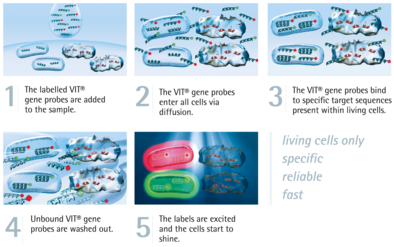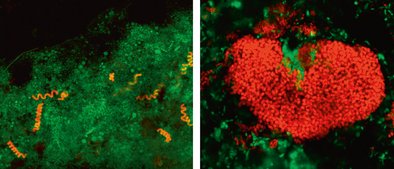VIT® Technology
The fast, reliable and highly-specific VIT® gene probe technology is a further development and the industrial standard of the FISH technology. It is made for the detection of microorganisms.
How VIT® works
The gene probe technology VIT® (vermicon identification technology) is the only technology that allows to visualize, identify and quantify microorganisms with extremely high specificity.
Dye-labelled and specifically designed VIT® gene probes enter the sample and bind with high specificity to individual vital micoorganisms. At the evaluation step, the shining and fully preserved microorganisms can be detected and quantified quickly and reliably.

Application of FISH for analysis of the microbiome
The human microbiome is a highly complex ecosystem composed of bacteria, archaea, fungi, protozoa, and viruses. This small universe of microorganisms is the subject of intense interest and research in the scientific communities. With the help of FISH (fluorescence in situ hybridization), bacteria can be analyzed directly in their habitat.
Dr. Jiri Snaidr, CEO and founder of vermicon AG explains how FISH works and which advantages it can provide, especially for scientists and companies active in the microbiome research.

Speed
VIT® is fast! Analysis takes only three hours to perform. Hands-on time is only a few minutes.

Specificity
VIT® gene probes are highly specific for single species or whole groups. The cumulated know-how of 20 years of gene probes research & development is concentrated in the gene probes' design.

Reliability & Robustness
Cells are not destroyed in the sample and there is no extraction of target structures. No interference-sensitive enzymes are required during the process.
The evolution of FISH
The VIT® gene probe technology is a refined version and the industrial standard of the FISH technology (Fluorescence In Situ Hybridization) for detection of microorganisms.
In the early 1990ies, FISH was developed for the detection of bacteria at the Chair of Microbiology (headed by Prof. Dr. Karl-Heinz Schleifer) of the Technical University of Munich. vermicon AG was founded in 1997 as a spin-off of this chair.
In the early years after its founding, the company focussed on refining the laboratory method FISH to a robust technology fit for industrial applications. In 2000, the VIT® gene probe technology was introduced.
VIT® unites all advantages of the FISH technology with additional robustness and increased specificity. Today, VIT® is the industrial standard of the FISH technology.
Only living bacteria
VIT® makes sure that only living bacteria will be detected.
Worldwide applications
Since 20 years VIT® is applied worldwide.
The FISH Original
Since the original development of the FISH method for the detection of bacteria at the Chair of Microbiology of the Technical University of Munich, the FISH method has been and is still being used in scientific research in universities all over the world. The results of the Chair of Microbiology were published internationally and received attention worldwide.
With vermicon AG and its products, you can always be sure to have the original. As a spin-off of the Chair of Microbiology, we have concentrated and diligently expanded profound know-how about FISH in our company from the very start.
Today, vermicon AG is the world leader in the application of the FISH technology for detection of microorganisms.

VIT® Advantages
Direct: analysis of the microbiology, directly in the sample
Fast: swift detection of changes; quick feedback after modifications of process parameters
Living bacteria only: dead bacteria are not detected
Easy: no calibration required; no indirect parameters
Specific: exact identification of bacteria, independent on their morphology
Comprehensive: up to 100% of the bacteria can be detected, regardless of their cultivability
Robust: no application of enzymes; no interferences
Stable: conserved samples allow for reproducible results over any period of storage